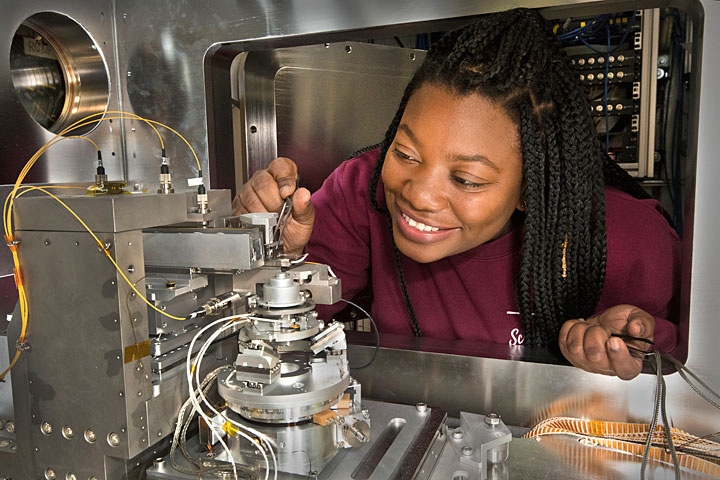Nov 19 2018
Ultrabright X-rays have been used by researchers at the National Synchrotron Light Source II (NSLS-II)—a U.S. Department of Energy (DOE) Office of Science User Facility at DOE’s Brookhaven National Laboratory—to image single bacteria with higher spatial resolution than ever before. Their efforts, reported in Scientific Reports, illustrate an X-ray imaging method, known as X-ray fluorescence microscopy (XRF), as an effective method to create 3D images of small biological samples.
 NSLS-II scientist Tiffany Victor is shown at the Hard X-ray Nanoprobe, where her team produced 3D chemical maps of single bacteria with nanoscale resolution. (Image credit: Brookhaven National Laboratory)
NSLS-II scientist Tiffany Victor is shown at the Hard X-ray Nanoprobe, where her team produced 3D chemical maps of single bacteria with nanoscale resolution. (Image credit: Brookhaven National Laboratory)
“For the very first time, we used nanoscale XRF to image bacteria down to the resolution of a cell membrane,” said Lisa Miller, a scientist at NSLS-II and the paper’s co-author. “Imaging cells at the level of the membrane is critical for understanding the cell’s role in various diseases and developing advanced medical treatments.”
The record-breaking resolution of the X-ray images was made viable by the progressive capabilities of the Hard X-ray Nanoprobe (HXN) beamline, an experimental station at NSLS-II with innovative nanofocusing optics and excellent stability.
“HXN is the first XRF beamline to generate a 3D image with this kind of resolution,” Miller said.
Although other imaging methods, such as electron microscopy, can image a cell membrane’s structure with extremely high resolution, these methods are incapable of providing chemical information on the cell. At HXN, the scientists could create 3D chemical maps of their samples, finding where trace elements are located throughout the cell.
“At HXN, we take an image of a sample at one angle, rotate the sample to the next angle, take another image, and so on,” said Tiffany Victor, the study’s lead author and a scientist at NSLS-II. “Each image shows the chemical profile of the sample at that orientation. Then, we can merge those profiles together to create a 3D image.”
Miller added, “Obtaining an XRF 3D image is like comparing a regular X-ray you can get at the doctor’s office to a CT scan.”
The images generated by HXN exposed that two trace elements, zinc and calcium, had distinctive spatial distributions in the bacterial cell.
“We believe the zinc is associated with the ribosomes in the bacteria,” Victor said. “Bacteria don’t have a lot of cellular organelles, unlike a eukaryotic (complex) cell that has mitochondria, a nucleus, and many other organelles. So, it’s not the most exciting sample to image, but it’s a nice model system that demonstrates the imaging technique superbly.”
Yong Chu, who is the lead beamline researcher at HXN, says the imaging method is also applicable to a number of other areas of research.
This 3D chemical imaging or fluorescence nanotomography technique is gaining popularity in other scientific fields. For example, we can visualize how the internal structure of a battery is transforming while it is being charged and discharged.
Yong Chu, Lead Beamline Researcher, HXN.
Besides breaking the technical barriers on X-ray imaging resolution with this method, the scientists formulated a new technique for imaging the bacteria at room temperature during the X-ray measurements.
“Ideally, XRF imaging should be performed on frozen biological samples that are cryo-preserved to prevent radiation damage and to obtain a more physiologically relevant understanding of cellular processes,” Victor said. “Because of the space constraints in HXN’s sample chamber, we weren’t able to study the sample using a cryostage. Instead, we embedded the cells in small sodium chloride crystals and imaged the cells at room temperature. The sodium chloride crystals maintained the rod-like shape of the cells, and they made the cells easier to locate, reducing the run time of our experiments.”
The scientists say that establishing the effectiveness of the X-ray imaging method, as well as the sample preparation technique, was the primary step in a larger project to image trace elements in other biological cells at the nanoscale. The team is especially keen to explore copper’s role in neuron death in Alzheimer’s disease.
Trace elements like iron, copper, and zinc are nutritionally essential, but they can also play a role in disease. We’re seeking to understand the subcellular location and function of metal-containing proteins in the disease process to help develop effective therapies.
Lisa Miller, Scientist, NSLS-II.
The work was supported by DOE’s Office of Science, the National Science Foundation, and the National Institutes of Health.